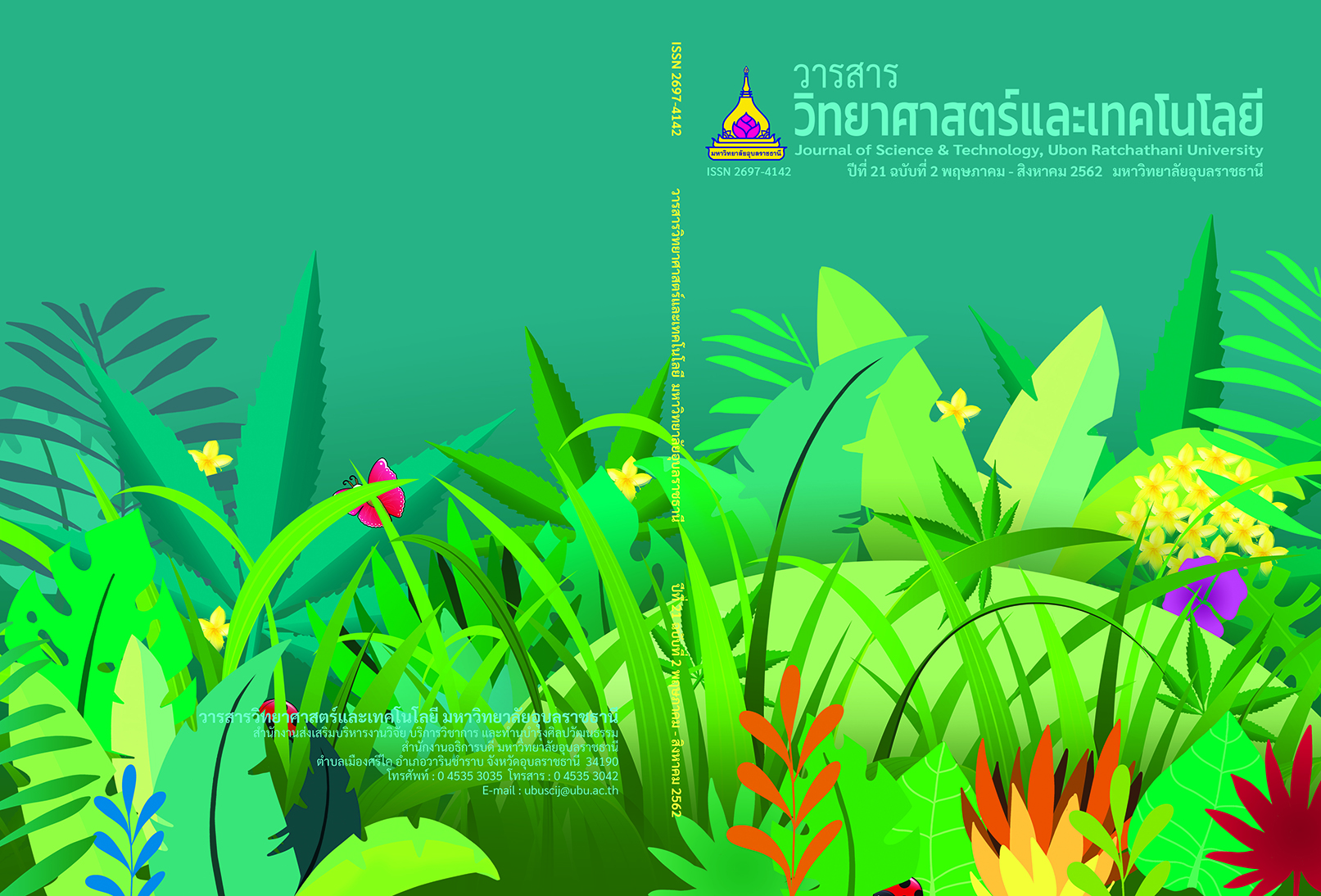ผลการเสริมใบถั่วคาวาลเคดเป็นแหล่งเยื่อใยอาหารต่อการย่อยได้แบบปรากฏของโภชนะ สมรรถนะการผลิต ลักษณะซาก และคุณภาพเนื้อของไก่เนื้อ
Main Article Content
บทคัดย่อ
บทคัดย่อ อาหารสัตว์ปีกที่มีเยื่อใยและโพลีแซ็กคาไรด์ที่ไม่ใช่แป้งสูงได้รับความสนใจอย่างมากในปัจจุบันสำหรับการส่งเสริมจุลินทรีย์ ที่เป็นประโยชน์และการพัฒนาระบบทางเดินอาหาร การศึกษานี้มุ่งแสวงหาการใช้ประโยชน์จากใบถั่วคาวาเคคเป็นแหล่งเยื่อใยอาหารในอาหารไก่เนื้อต่อการย่อยได้แบบปรากฏของโภชนะ สมรรถภาพการผลิต ลักษณะซาก คุณภาพเนื้อ และผลตอบแทนทางเศรษฐกิจ โดยใช้ไก่เนื้อการค้าสายพันธุ์ Ross 308® อายุ 1 วัน จำนวน 320 ตัว สุ่มเข้าสู่ 4 ทรีทเมนต์ ทรีทเมนต์ละ 4 ซ้ำ จำนวนไก่เนื้อ 20 ตัวต่อหน่วยทดลอง ทำการเลี้ยงไก่เนื้อโดยใช้ระยะเวลา 35 วัน ภายใต้สภาพแวดล้อมตามธรรมชาติการทดลองนี้ใช้แผนการทดลองแบบสุ่มสมบูรณ์และมีอาหารทดลองที่เสริมใบถั่วคาวาเคคที่ระดับ 0, 5, 10, และ 15 เปอร์เซ็นต์ ผลการทดลอง พบว่า ไก่เนื้อกลุ่มควบคุมและกลุ่มที่ได้รับการเสริมใบถั่วคาวาเคค 5 เปอร์เซ็นต์มีการย่อยได้แบบปรากฏของวัตถุแห้ง (cubic, P<0.01) และเยื่อใยหยาบสูงสุด (cubic, P<0.05) แต่การย่อยได้แบบปรากฏของโปรตีนหยาบ ไขมันรวม และ พลังงานรวมของไก่เนื้อมีค่าใกล้เคียงกันระหว่างกลุ่มการทดลอง (P>0.05) ในช่วงอายุ 1 ถึง 21 วัน ไก่เนื้อทุกกลุ่มการทดลองมีปริมาณการกินได้ใกล้เคียงกัน (P>0.05) ส่วนการเสริมใบถั่วคาวาเคคในอาหารไก่เนื้อที่ระดับ 5 เปอร์เซ็นต์สามารถเพิ่มประสิทธิภาพการใช้อาหารและดัชนีประสิทธิภาพการผลิตสูงกว่ากลุ่มการทดลองอื่น (P>0.05) ทั้งนี้ระดับของการเสริมใบถั่วคาวาเคคในอาหารไก่เนื้อที่เพิ่มขึ้นจะแปรผกผันต่อน้ำหนักตัวที่เพิ่มขึ้น อัตราการเจริญเติบโตต่อวัน ประสิทธิภาพการใช้อาหาร และดัชนีประสิทธิภาพการผลิต (quadratic, P<0.05) ส่วนในช่วงอายุ 0 ถึง 35 วัน พบว่า การเสริมใบถั่วคาวาเคคในอาหารไก่เนื้อ ที่ระดับ 0, 5, และ 10 เปอร์เซ็นต์ ทำให้น้ำหนักตัวที่เพิ่มขึ้น ประสิทธิภาพการใช้อาหาร และดัชนีประสิทธิภาพการผลิตใกล้เคียงกัน (P>0.05) นอกจากนี้ยังพบว่าการเสริมใบถั่วคาวาเคคในปริมาณเพิ่มขึ้นในอาหารไก่เนื้อที่ไม่มีผลต่อเปอร์เซ็นต์ซาก เปอร์เซ็นต์ชิ้นส่วน และ คุณภาพเนื้อไก่ (P>0.05) การทดลองนี้แสดงให้เห็นว่าสามารถใช้เป็นใบถั่วคาวาเคคเป็นวัตถุดิบอาหารโปรตีนที่เหมาะสมในอาหารไก่เนื้อและแนะนำระดับการเสริมใบถั่วคาวาเคคที่ 5 เปอร์เซ็นต์ในอาหารไก่เนื้อช่วง 1-21 วัน และที่ 10 เปอร์เซ็นต์ในอาหารไก่เนื้อช่วง 22-35 วัน
Abstract High fiber and nonstarch polysaccharide-base poultry diets have received more interest recently for retaining or promoting beneficial microbial population and gastrointestinal tract development. The current study investigated the efficacy of a centurion leaf meal as dietary fiber in broiler chicken diets considering on apparent nutrient digestibility, productive performance, carcass trait, meat quality, and economic benefit return. In total, One hundred and ninety two, one day old of Ross 308® chicks were allocated in four dietary treatments, each of which was replicated four pens with twenty broilers per replicate and birds were raised up to 35 day in the environmental condition. A completely randomized design was used in this study, dietary treatments were the levels of centurion leaf meal in diet at 0, 5, 10, and 15 %. The results of the control group and 5 % supplementation of centurion leaf meal groups revealed a significant improvement in nutrient digestibility of dry matter (cubic, P<0.01) also effected to crude fiber digestibility (cubic, P<0.05) but including not significantly affect the apparent crude protein, ether extract, and gross energy digestibility among treatment group. During the starter phase (1–21 day), experimental diets had no effect on feed intake (P>0.05). There was no effect of 5 % supplementation of centurion leaf meal groups on the measured FCR, and productive index (PI) compared to control (P>0.05). However, centurion leaf meal supplementation tended to reduce body weight gain (BWG), ADG, FCR, and PI (quadratic, P<0.05) compared to control. During the grower phase (22–35 day), Chicken fed a diet containing 5 and 10% of centurion leaf meal showed a significant increase in BWG, ADG, FCR, and PI compared to control group. (P>0.05). Additionally, supplementation of increasing levels of centurion leaf meal showed not effect on carcass characteristics, cutting percentage, and meat quality (P>0.05). The results implied that centurion leaf meal could be used as suitable protein feedstuffs in broiler diets and shown that the use of diet supplemented with 5 % of centurion leaf meal in 1-21 day and 10 % of centurion leaf meal in 22-35 day.
Article Details
บทความที่ได้รับการตีพิมพ์เป็นลิขสิทธิ์ของ วารสารวิทยาศาสตร์และเทคโนโลยี มหาวิทยาลัยอุบลราชธานี
ข้อความที่ปรากฏในบทความแต่ละเรื่องในวารสารวิชาการเล่มนี้เป็นความคิดเห็นส่วนตัวของผู้เขียนแต่ละท่านไม่เกี่ยวข้องกับมหาวิทยาลัยอุบลราชธานี และคณาจารย์ท่านอื่นๆในมหาวิทยาลัยฯ แต่อย่างใด ความรับผิดชอบองค์ประกอบทั้งหมดของบทความแต่ละเรื่องเป็นของผู้เขียนแต่ละท่าน หากมีความผิดพลาดใดๆ ผู้เขียนแต่ละท่านจะรับผิดชอบบทความของตนเองแต่ผู้เดียว


